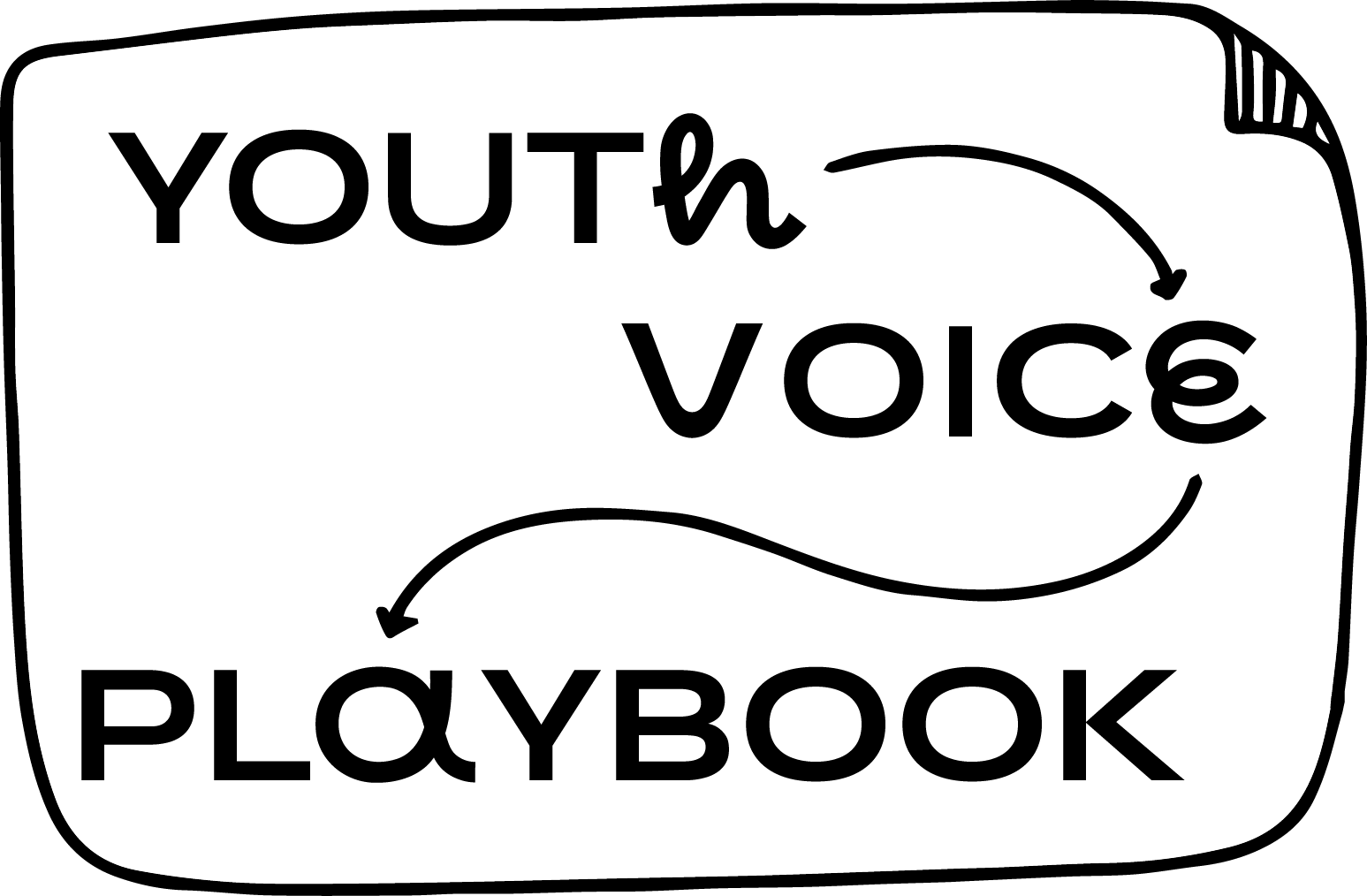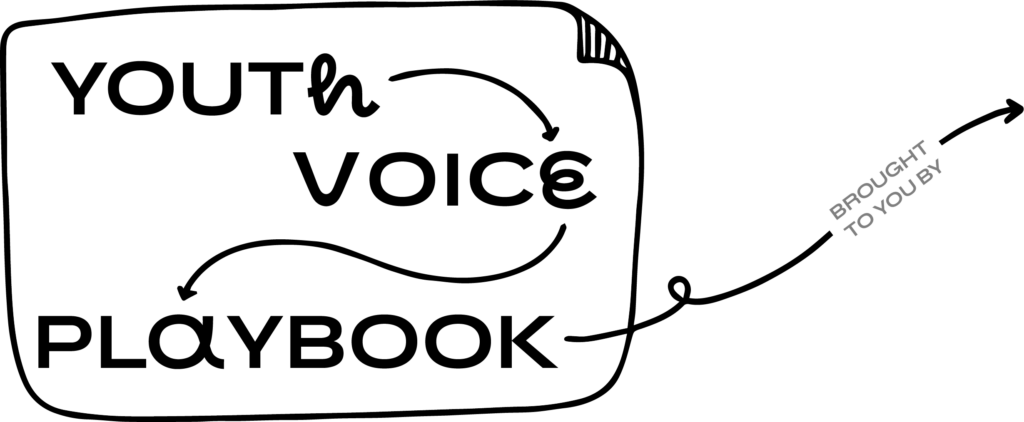Everyone loves PowerPoint, right?
I’ll just present my project once the kids get here and then ask them what they think.
I dont want to be too bossy…
I’ll just wing it and see how it goes!
Teens like to talk, right?
This should be pretty easy.
OK, we’re teasing… but in all seriousness, this chapter is a gold mine of activity ideas, whether you’re totally new to participatory youth research or have done it for years. Even if you already have some good ideas, there’s a trove of cool examples in the Resources section at the end of this one, so bookmark it and come back anytime you need fresh inspiration.
We promise that this chapter will be mostly interactive! It’s got a really extensive Resources section, so if you just want some practical templates, jump right to the end. But before we get there, we do want to share an overview of things to keep in mind if you’re new to this work. So let’s dive in!
In this chapter:
- How to plan effective activities
- Start with the goal, not the activity.
- Prioritize a sense of belonging.
- Plan, but keep it only semi-structured.
- “Measure twice, cut down on error.”
- Make it easy to participate.
- Share the right details.
- Don’t try to be too cool.
- Include an activity that helps people test their tech beforehand.
- Keep it interactive and use multiple modes for participation and engagement.
- Upgrade from a ‘one and done’ working model.
- Resources, activities, & digging deeper
- Tech platforms we use a lot
How to plan effective activities
Start with the goal, not the activity.
This is lesson planning 101 – always start with your objectives. What do you want participants to learn, contribute, feel, or do during the session? What do YOU hope to learn? Write this down and make sure you’re clear on it before you plan your activities. It’s tempting to start with an activity first (“ooh, I loved that fishbowl thing I did at that training… let’s do that!”) but it’s important to think first about the why, and then move to the how. If you’re having trouble figuring it out, ask yourself, “How will I know if the session has been a success?” This can give you some insight into your goals.
Prioritize a sense of belonging.
As you’re planning, it can be easy to dive right into the activities that will “get to the meat” of what you want to learn. However, it’s important to start by designing moments to help each participant feel valued and validated so that they know their presence and perspective matters. This can go a long way in helping them feel engaged and able to share honestly (Master & Meltzoff, 2020). There are lots of possible ways to do this, like planning intentional icebreakers to create points of connection between the participants in your group, or simply introducing yourself directly to each student as they show up and telling them why you’re so glad they came. Check out the Resources section at the end of this chapter for practical examples, and read chapter 6 for more on how to set group norms and kick off your session effectively.
Plan, but keep it only semi-structured.
Make a plan for how you want to use your time together, but leave room for flexibility and improvisation (Lee et al., 2021). You should come prepared with a plan for the activities you plan to facilitate, how you’ll guide people through them, and approximately how long you’ll want to spend on each one – as well as which ones you can cut if you run out of time! The session will likely go differently than you imagined, and it’s important to be responsive to what’s actually happening in the room. Ironically, we’ve found that when we have clear goals and a specific plan, we can actually pivot more easily and successfully, because our priorities are clear to the team.

Example from Center for Digital Thriving
Our basic structure when we have multiple sessions with the same group is “Open Up, Build On, Dive In, Stand Back.” It works like this:

Example from Hopelab
When we only have a single session and limited time with the group we’re working with, we tend to use the following structure:
- Set a fun and friendly tone and save time by designing an icebreaker that also teaches participants how to use a collaboration board. Here’s one activity we’ve used to do this.
- Open with a low-stakes question that gives everyone a chance to practice talking within the group early in the session. For example, we often ask each young person to introductive themselves, share their preferred pronouns, and answer an easy question like “Where are you calling in from?” or something more fun like “What’s a song that’s been stuck in your head this week?”
- Start broad and light and get more specific and into heavier topics later once more trust/rapport is built. For example, a relatively light and broad question might be “Tell us what social media platform you like the most and why you like it.” A heavier question might be something like “How do you cope with negative or hateful content you encounter on social media?”
- Zoom back out at the end to let participants know where the research team plans to head next, and ask for participants’ perspective on important future directions. For example, you might ask more expansive questions that allow youth input on the project as a whole, such as “Is there anything important that we didn’t touch upon that you want us to keep in mind?” or “Who do you think most needs to hear the results of this survey and how should we share them?”
“Measure twice, cut down on error.”
Everyone knows that old proverb, right? 😉 Here’s what we take this nerdy version to mean: you should test out your ideas, protocols, prototypes, and items before you use them to make sure they actually make sense. This is called cognitive pretesting: “a structured approach for learning how respondents interpret items” (Gehlbach & Brickworth, 2011, p. 14). For example, if you are hoping to eventually use a survey with young people, it’s wise to test the questions in it ahead of time with a sample of similar young people to make sure they are clear, relevant, and not easily misinterpreted. This can result in much higher quality data once you actually begin data collection. The principle also applies to planning your activities – sometimes it’s worth it to run through your planned activities with a couple of young people before the full group arrives, to make sure that your instructions are clear, time estimates are realistic, and activities seem engaging.

Example from Center for Digital Thriving
In collaboration with social psychologist Sara Konrath, our team developed a set of items to create and validate a measure of mindful and prosocial technology use for adolescents. A critical step in our process was conducting cognitive interviews with teens ahead of conducting a study with a larger sample of teens ages 13-17. For these interviews, we intentionally recruited five teens of different gender and racial identities and on the younger and older ends of the target age band of our larger study. We used a “think-aloud protocol” where the teen would read each item (e.g., “I get distracted by my phone and it takes me out of the moment”) and share their thinking about it – how they interpreted the question, whether any aspects of the question were confusing or unclear, and how they would answer given the response options provided. This process helped us adjust the wording of individual survey items so they were clearer and more effectively capturing what we wanted to study. It also helped us identify items to remove because they were confusing or redundant.
Make it easy to participate.
Try to set a “low floor” — create accessible entry points, describe the project in an easy-to-grasp way; limit any reading or pre-work to the essential. This doesn’t mean “dumbing down” complex concepts, but it does mean thinking about how to make them approachable for young people who might not really know what this project is about, or who are nervous about being involved. You want to make people feel comfortable, like “I get what this is about, and I definitely have some thoughts on this.”
Share the right details.
It’s okay to make editorial choices to focus people on the parts you really want them to dig into. For example, let’s say you want to discuss your findings from a recent survey. You might be tempted to share the whole survey and a detailed table of your findings. Resist this urge! It’s often TMI and can bog down the discussion. Instead, focus on just pulling a few essential questions from the survey, or giving details about the key measurements and indicators you used. If your study is about mental health, you might want to share exactly how you asked about symptoms of depression, but you don’t need to have your group spend the entire session reading through every question of the full survey. One similar consideration for sharing findings: consider using headlines or graphics, rather than tables of findings that can be harder to interpret.
Don’t try to be too cool.
Avoid anything that could be viewed as adults trying to cater to the stereotypical “Gen-Z” crowd. Yes, make your activities fun and engaging and personable, but just be your normal grown-up self!
Include an activity that helps people test their tech beforehand.
This sounds dull, but we cannot overstate its importance. It’s tempting to skip this step because it takes more time and resources, and because we often assume that young people are digital natives and therefore know all the things about digital tools. But everyone needs a minute to orient themselves to how you’re using tech in a particular setting, so you should build in that orientation time.
There are lots of fun ways to onboard people live to tech platforms like virtual whiteboards (eg. Whimsical, Mural, Miro), learning environments (eg. Nearpod, Google Classroom), or collaborative docs (eg. Google Slides, Docs, or Jamboard). A few examples are included in the Resources section of this chapter. You can also send video instructions via Loom, Zoom recordings, or other screen sharing platforms to give a video tutorial on how you will use your interactive platforms.

Example from Character Lab
Our youth voice program kicks off each year with a week-long virtual summer training on Zoom. The week before the training, we host multiple short onboarding sessions where students can practice logging on to Zoom and opening the collaborative tools we’ll use during the training. This lets us address some of those tech bugs (“I can’t hear anything…”) ahead of time in a smaller group setting, so we can hit the ground running during the training itself. It also helps relieve student nerves about showing up in a Zoom meeting with 150 other students, since the tech calls are smaller. And, it lets us give personalized attention to students who are struggling with the tech to ensure that they don’t miss important content during the actual training. We always include some fun icebreakers in these sessions too, which helps students feel like they have some friendly faces when they actually show up for the training itself the following week.
Keep it interactive and use multiple modes for participation and engagement.
Try to remember what you were like when you were fourteen. Would you have wanted to have participated in a 1:1 interview or focus group with a researcher? Answers to this question probably vary from an enthusiastic ‘yes!’ to a ‘heck no!’ The reality is that different youth have very different comfort levels participating in youth voice activities. Some are more comfortable in a small group, others prefer 1:1, and others actually find large groups most welcoming. Because young people have different preferences and we want all of the youth in our group to feel as comfortable as possible, we recommend offering young people a range of ways to provide their perspective: direct conversations, small- and full-group activities, real-time contributions in the chat, asynchronous and even anonymous feedback.
This advice also applies to live sessions where you’re gathering young people into one virtual space. Often it’s helpful to provide instructions and methods for response in multiple modalities. For example, you might have instructions displayed on the screen and ask for a volunteer to read them out loud. Or you might give people the option to either type their answer to a question in the chat, unmute and share their thought out loud, or simply reflect quietly and submit a video recording of their ideas later. Using multiple modalities – both written and audio, for example – also helps ensure that even if a student’s audio cuts out, or their Zoom connection freezes for a bit, they can catch up more easily with the activity.
Whatever you do, don’t talk for more than 10 minutes straight, and plan to utilize a handful of interactive elements that can mix it up!
Upgrade from a ‘one and done’ working model.
We have found that the single session model has drawbacks that can be addressed by having repeated sessions with the same group. Repeated sessions let you build rapport and give you more time to engage in content and feedback.
We’ve found 60 to 75 minutes is a sweet spot for us in terms of length; longer creates risk of fatigue, and less time can feel “rushed” or crowd out time for rapport-building. Planning 15 extra minutes also gives you more flexibility if the session goes by faster than you anticipated – it’s ok to end early!
Resources, activities, & digging deeper
Ways to do cognitive pretesting
Think Aloud
Encourage unfiltered thinking.
The general idea of a think-aloud protocol is to have young people narrate their thought process so you can learn from their unfiltered reactions.
More Info
There are lots of ways to do this. One is to just invite participants to share the first thing that comes to mind as they read survey questions aloud, and follow up with curiosity to their initial reactions. Another is to have them read survey questions aloud, and then share their interpretation of the questions, whether they find anything confusing, and how they would answer it.
More versions and tips for using think-aloud protocols here!
Survey
An asynchronous option.
You can use surveys to do cognitive pretesting asynchronously and in writing.
Ways to set the tone, break the ice, or welcome the group
Visual Pulse Checks
Get a read of where the group is.
Pulse checking is a visual way to see where the group is through interacting with virtual or physical sticky notes. Ask the entire group a question and have them answer collectively so everyone can see how people are showing up in the space.
Example
Here’s an example “pulse check” activity on Mural that you can use to see how people are showing up in the space.
Icebreakers
A classic for a reason.
Icebreaker questions are always a fun way to get people talking. You can have people unmute or type in the chat; you can do them in a large group, pairs, or breakout rooms.
Our favorites
- If you had a totally free afternoon, how would you spend it?
- What’s one thing you do every day or most days?
- What is one unexpectedly good thing that happened today or this week?
- If your mood was a weather forecast, what would it be?
- What is your favorite childhood movie?
- What’s the best sandwich and why?
- What’s the scariest animal and why?
- What’s your favorite smell and why?
Impromptu show and tell
Break the 4th wall of the Zoom room.
This is a good one to encourage people to keep their cameras on and share a bit about their lives. Invite everyone to get up, grab an object in the room where they are sitting, and tell everyone about it.
Tip
Add a theme (e.g. something sentimental, something you use all the time). You can also have people grab something random!
Make Connections
Finding the common among the uncommon.
Split people into pairs and give them the prompt. “Try to identify two non-obvious things you have in common.” (e.g. we both broke a finger, hate mayo, are obsessed with __.)
Extend
You can also do multiple rounds to facilitate more connecting-making!
Lists of Five
Encourage unfiltered thinking.
Tell everyone to open a notes app and get ready to write! Give them 20 seconds to write down a list of five things that fit into a certain category. Start with fun categories and have people paste their lists in the chat so you can read and react. Then, if you want, you can move to lists of more substantive topics.
Example Categories
Fun Categories: Five things you have in your fridge, five songs you can’t stand, five snacks you could eat forever, etc.
Substantive Categories: Five things you hope to get out of this session, or five norms you’d like to set for the time together. (For more on setting norms, check out chapter 6!)
Mind/Body/Heart
A dynamic and repeatable starter.
Once you’ve established rapport within the group, ask everyone to share their “Mind/Body/Heart Score” by thinking about what number they would give their current state of mind (e.g., thinking, focus, presence), body (physically), and heart (emotionally, spiritually) on a scale of 1 (low) to 10 (high). Ask everyone to put their three numbers in the chat (e.g., “8/6/9”, or “Mind 8, Body 6, Heart 9”).
Extend
If you have time, go around and have each person elaborate on one of the numbers they shared.
Comfort/Chaos
A quick way to gauge where a group is emotionally and cognitively.
Draw three concentric circles on a whiteboard (physical or virtual) and label the circles: “Comfort” (the smallest circle in the center), “Challenge” (also called “Learning,” but we like the alliteration of the 3 C’s!), and “Chaos” (the largest circle). Ask everyone to write their name on a sticky note and plot it where they are at that moment.
More Info
Note that there’s no wrong place to be. For example, sometimes being in our comfort zone is just what we need; other times chaos is quite generative. This activity simply gives the group a glimpse into something that is otherwise hard to see, and invites you to adjust the pacing, content, or activities to meet them where they are.
Ways to solicit participants’ ideas, feedback, and sharing
Clint’s Circle
A listening practice.
The facilitator offers a few questions and then everyone in the group has a turn to respond to one question of their choosing. When it’s your turn, you choose which question you want to answer and share your response. After you’ve answered, the next person shares which question they want to answer and offers their reply – and so on.
More Info
If you have time, you can then do a second “round” where people share comments based on the ideas shared in round one. This method is especially helpful when you are in the first session and building rapport with participants. The practice allows each participant to share their opinions and also promotes listening among facilitators and the participants.
Pair & Share
A classic classroom move!
Think, pair, and share is a pretty straightforward method that gives people time to reflect individually, then talk with a partner, and then talk with the larger group.
More Info
This method can be a really helpful activity if you notice that you have some “eager beavers” in the group who often answer while others are still thinking – it gives more reflective or reserved participants a little extra time to gather their thoughts and test them out with a small audience before sharing with the whole group.
Thinking Routines
Make thinking visible.
To facilitate this type of activity, you can set up a virtual whiteboard with piles of sticky notes already organized into the chosen categories, so that students can write their thoughts in each section. This can get lots of great ideas out and then spark a more free-flowing discussion.
Our Favorites
There are a lot of helpful thinking routines that organize thinking and spark different types of reflection. A few of our favorites are:
Speed Thinking
Build energy through quick convos.
Have quick paired conversations to facilitate “speed thinking,” followed by asking each pair to report out what they discussed to get ideas into the shared space.
Extend
Speed thinking is exceptionally paired with the thinking routines activity. After you’ve run 2 or 3 rounds, ask folks to reflect on what they heard with a framing like “notice / wonder / connect.”
Card Sorting
A low stakes way to disagree.
Ask participants to sort topics, findings, or ideas into categories (e.g. essential, interesting, and not as important). This can be a valuable and low-stakes way for young people to contradict assumptions you might be making about what’s important to focus on in your research!
Example
An example from Hopelab of how to set this up on a virtual whiteboard is here.
Alien Invasion
Think outside the atmosphere.
Invite participants to imagine they were explaining a topic, tool, or phenomenon (e.g. social media) to a curious alien who wants to know if they should bring it back to their planet.
Prompts
You might use prompts like: What is this used for? How does it make teens feel? If we bring this back to our planet, do you have any warnings for us?
Freewrites
Find out what you think and feel.
Set a timer for 5 minutes and share a prompt. Clarify up front that people will not be asked to share their writing with anyone; this is just a strategy to help them do some processing before discussion begins. It can be especially helpful for folks who need a bit more independent ‘think time’ before a conversation gets going.
The Only Rule
The only instruction is that people must keep writing for the full five minutes – sometimes there’s some magic in what comes up after they think they’ve run out of things to say!
Tip: If they don’t know what to write about, tell folks to write about not knowing what to write about.
Triz
Design for the opposite problem.
Explore solutions by designing for the opposite problem. For example, if you are exploring healthy tech habits, how might you design an app that encourages the worst possible habits ever?
More Info
With TRIZ, you can discover approaches you’d never take by flipping the problem on its head. It’s generally done in three steps: First, make a list of all you can do to achieve the most unwanted result (silly ideas are totally welcome at this stage – anything goes). Then, make a second list of how many of those ideas currently resemble reality. Last, think of the first thing you’d do to intervene.
Headlines
Encourage synthesis.
Format the main findings of your research on which you want youth feedback as newspaper headlines, and ask youth to vote on the headlines that resonate, raise questions for them, and/or that they’re skeptical of.
Tips and Examples
Be selective in what to include – we’ve found that presenting more than 8 headlines total to be overwhelming. Consider pairing headlines with a “take the pulse” activity like dot voting or emoji voting so you can capture initial reactions and kick off conversation. An example from Hopelab of how to set up a headlines activity on Mural can be found here.
Ways to take the pulse of the room
Polls
An anonymous snapshot of group sentiment.
There are lots of ways to take a quick poll. You can set one up on Zoom with a question like “How skeptical of this finding are you?” and let students cast their votes anonymously.
Tip
Polling can be a helpful way of drawing out other opinions if you’ve mostly heard agreement.
Dot Voting
Take a visual temperature of the group.
Offer everyone a set number of dot stickers and tell them that they can allocate them as they wish. If they like multiple ideas, they can distribute their dots across those ideas; if they have one strong favorite, they can put all their stickers on that idea. Everyone votes at the same time, and the results can help see the group’s priorities and how distributed or grouped they are.
Example
This works especially well on whiteboard (you know by now that we love a virtual whiteboard!). A template for how to set this up on Miro can be found here.
Gradients of Agreement
Invite nuance in decision-making.
This technique gives a more nuanced view of where the group is at, by inviting every participant to share where they are at regarding a decision, from serious disagreement to whole-hearted endorsement. The scale, along with some adaptations and suggestions for how to use it, can be found here.
Tip
To facilitate this virtually, you can simply display the scale and have people hold up the number of fingers that represents their position on the scale, or you can use a poll, or you can have people drop a sticker on their position on the scale… it’s up to you!
Emoji Annotations
😍, 😃, 😬, 🤨, 😳, 😠, 🙁, 🙄, 🤔
Create a “bank” of emojis showing different reactions (e.g. 😍, 😃, 😬, 🤨, 😳, 😠, 🙁, 🙄, 🤔…) and invite youth to copy and place them to show their reaction to various ideas on a whiteboard. This allows them to convey an emotional reaction to each idea, which can then be further explored through discussion.
Tip
You may want to talk about the emojis in the bank before you begin to see if any important emotions are missing, and also to make sure that you don’t have a vastly different understanding from your youth team about the emotions that any of them are conveying.
Tech platforms we use a lot
Please note: Institutional Review Boards (IRBs) have varying regulations regarding the use of online software. Always consult your specific IRB’s guidelines and obtain necessary approvals before utilizing these technologies in research. More on IRBs in chapter 2!

Mural
Mural is an online whiteboard and collaborative space. Here’s a link to a fun activity you can use to help orient people to how to use Mural.

Whimsical
Whimsical is another online whiteboard tool. Here’s a cute “find the monster” activity that can help you learn how Whimsical works.

Miro
Miro is another online whiteboard tool! Wow, we must really love whiteboards! Here’s an overview from Miro of how their platform can help facilitate virtual gatherings.

Google Slides
Slides is a fruitful collaborative whiteboard-esque space. Teens are often familiar with it, and it’s free. (It doesn’t work well on mobile devices, though.)

Zoom
Zoom is a tried-and-true for lots of reasons, but we especially love it because of features like polls, breakout rooms, chat, and interpretation tools like auto-generated translation and captioning.

Loom
Loom is one of several video-recording and sharing platforms we like. It’s even what we used to work collaboratively and asynchronously on this gigantic playbook! It lets you record and embed videos into other platforms.

Flip
Flip (formerly called Flipgrid) is a video discussion tool that lets participants record their own video responses. For example, you can ask a question and then send out the link, and everyone in the group can record a video response to that question. You can control whether people can see each other’s responses or not.

Nearpod
Nearpod is a more traditional classroom tool, but it has a lot of great templated activities and is pretty fun and interactive. It’s particularly useful for large groups, since it does a lot of data aggregation for you.
What to Read Next
The day is approaching! You have a plan for the session, including a bunch of engaging activities. You’ve prepared your online whiteboards, made sure everyone knows the logistics about when and where to show up, and now you’re ready to welcome young people… at least in theory. But in practice, how do you set the tone when they first arrive, and invite them to join you in this experience you’ve planned? Jump to chapter 6!




























